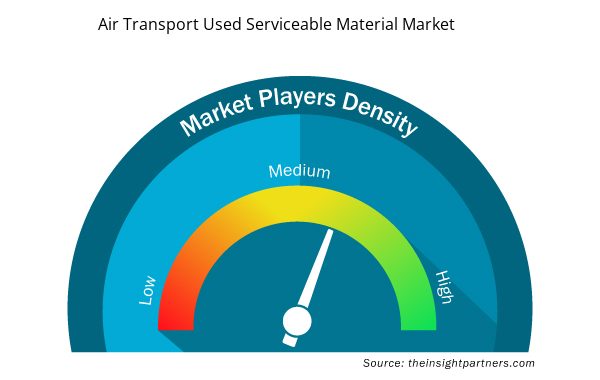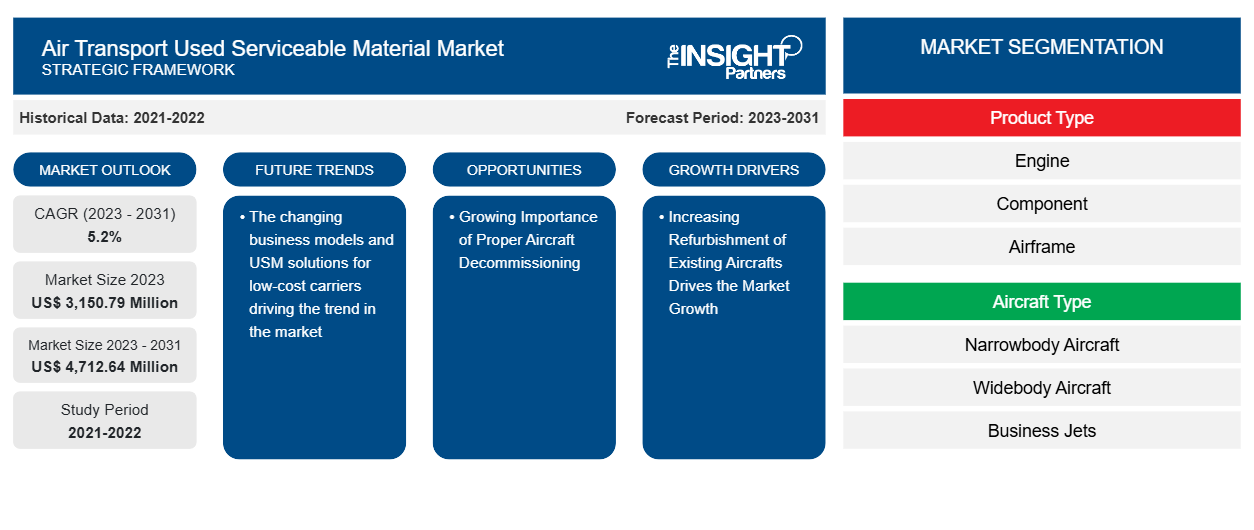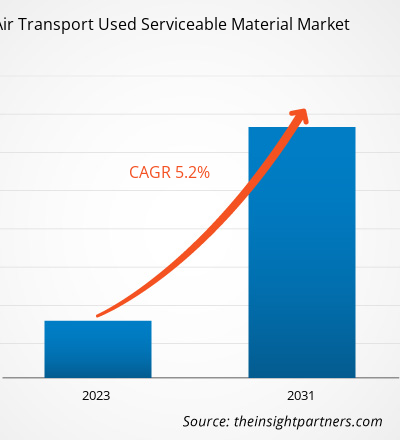航空运输用过的可维修材料市场规模预计将从 2023 年的 31.5079 亿美元增至 2031 年的 47.1264 亿美元。预计 2023-2031 年期间,市场复合年增长率将达到 5.2%。低成本航空公司不断变化的商业模式和 USM 解决方案正在推动市场趋势。MRO 公司的运营和商业模式正在迅速变化,而这又受到激烈竞争和不断变化的全球动态等因素的驱动。企业之间日益激烈的竞争,加上航空公司机队的不断发展和航空业的新进入者,威胁到了 MRO 公司的可持续性,从而促使参与者寻找创新的商业模式。
航空运输二手可用材料市场分析
航空业在制造技术、MRO 技术和飞机采购趋势方面不断经历重大变化。过去几年,民航公司、公务机所有者和地区航空公司从航空涡轮燃料成本的下降中获益匪浅。另一方面,发动机制造商非常重视并充分利用长寿命飞机发动机的生产。飞机发动机寿命的延长导致航空发动机行业的售后市场供应链受到挤压。同样,航空涡轮燃料成本的下降也促使飞机所有者将现有机队保留更长时间,从而缩短了飞机的拆卸时间。这两个因素对使用可维修材料的航空运输增长产生了积极影响。
航空运输二手可用材料市场概览
航空运输可用材料 (USM) 用于四种类型的飞机,用于处理某些主要飞机部件的维修故障。USM 可确保更短的产品安装时间并降低成本。航空运输使用可用材料,主要用于窄体飞机。窄体飞机可以小到过道两侧各有一个座位,而最常见的窄体喷气式飞机在过道两侧有三个座位。波音 737 空客 A318/319/320/321 是一些流行的窄体喷气式飞机型号。所有主要飞机制造商都从事窄体飞机的制造,波音、空客、庞巴迪、巴西航空工业公司和图波列夫等是全球生产窄体飞机的一些主要飞机原始设备制造商。这一因素是全球窄体飞机中 USM 使用量不断增加的主要驱动因素之一。
定制此报告以满足您的需求
您可以免费定制任何报告,包括本报告的部分内容、国家级分析、Excel 数据包,以及为初创企业和大学提供优惠和折扣
- 获取此报告的关键市场趋势。这个免费样品将包括数据分析,从市场趋势到估计和预测。
航空运输用旧材料市场驱动因素和机遇
现有飞机翻新增加推动市场增长
全球空域对商用飞机的空中旅行需求巨大。这促使航空公司和国防部队使其机队随时准备使用最新技术并确保集成强大的部件。现有商用飞机的翻新是目前航空业的一大趋势。预计这一趋势将在此期间激增,为飞机零部件供应商和维护、修理和大修 (MRO) 公司带来巨大机会。飞机的翻新包括发动机、起落架、雷达和天线等。USM 供应商确保以更低的成本和更高的可靠性提供一些主要飞机零部件,这增加了飞机制造商的兴趣。因此,此类项目推动了对航空运输 USM 的需求,因为这些是市场上可用的低成本替代方案。
妥善退役飞机的重要性日益增加
根据国际航空运输协会的数据,过去 35 年来,全球有超过 15,000 架商用飞机退役。平均每年约有 700 架商用飞机达到使用寿命。各种经济因素导致当今飞机的提前退役,飞机的平均使用寿命通常在 20 至 36 年之间。飞机退役已成为一个至关重要的过程,必须有效管理以避免任何环境和安全风险。
航空运输用可维修材料市场报告细分分析
有助于得出航空运输用可用材料市场分析的关键部分是产品类型、飞机类型、供应商和地理位置。
- 根据产品类型,市场分为发动机、飞机部件和机身。其中,发动机在 2023 年的份额最大。这是由于对飞机部件更换的需求不断增加。对剩余航空部件的需求不断增加,在重塑航空公司售后市场战略方面发挥了重要作用。向非发动机按小时计费和其他保证服务水平协议的转变使 USM 发挥了更突出的作用,从而增加了对零件的需求。
- 根据飞机类型,市场分为窄体飞机、宽体飞机、公务机和支线飞机。在飞机类型中,窄体飞机是 USM 最大的用户,因为它们拥有大量在运营的机队。
- 根据供应商的不同,市场分为 OEM 和非 OEM。其中,OEM 预计将在 2023 年占据最大份额。
航空运输二手可用材料市场份额按地区分析
航空运输用过的可维修材料市场报告的地理范围主要分为五个区域:北美、亚太、欧洲、中东和非洲、南美和中美。
由于拥有多家领先的飞机制造商,预计北美将在预测期内主导全球航空运输二手可维修材料市场。主要关键参与者包括波音、空客直升机、湾流宇航、洛克希德马丁、派珀飞机、拜伊宇航、西锐、达索航空等。北美航空运输二手可维修材料市场基于美国、加拿大和墨西哥航空业的不同趋势进行分析。北美航空业在机身、发动机、航空电子设备、内饰和其他部件方面不断见证技术进步。不断增长的航空旅行需求不断推动飞机原始设备制造商提供高科技飞机,而 MRO 公司对快速 MRO 服务的需求也巨大。
在目前的市场情况下,航空涡轮燃油价格的下跌对北美机队和旅行的增长产生了积极影响。燃油价格的下跌,加上飞机交付的延迟,导致航空公司或飞机最终用户在较长时间内持有现有机队。这导致飞机退役速度缓慢。
航空运输二手可用材料市场区域洞察
Insight Partners 的分析师已详尽解释了预测期内影响航空运输二手可维修材料市场的区域趋势和因素。本节还讨论了北美、欧洲、亚太地区、中东和非洲以及南美和中美洲的航空运输二手可维修材料市场细分和地理位置。

- 获取航空运输二手可维修材料市场的区域特定数据
航空运输用过的可维修材料市场报告范围
| 报告属性 | 细节 |
|---|---|
| 2023 年的市场规模 | 31.5079亿美元 |
| 2031 年市场规模 | 47.1264亿美元 |
| 全球复合年增长率(2023 - 2031) | 5.2% |
| 史料 | 2021-2022 |
| 预测期 | 2023-2031 |
| 涵盖的领域 | 按产品类型
|
| 覆盖地区和国家 | 北美
|
| 市场领导者和主要公司简介 |
|
航空运输二手可维修材料市场参与者密度:了解其对业务动态的影响
航空运输二手可维修材料市场正在快速增长,这得益于最终用户需求的不断增长,这些需求源于消费者偏好的不断变化、技术进步以及对产品优势的认识不断提高等因素。随着需求的增加,企业正在扩大其产品范围,进行创新以满足消费者的需求,并利用新兴趋势,从而进一步推动市场增长。
市场参与者密度是指在特定市场或行业内运营的企业或公司的分布情况。它表明在给定市场空间中,相对于其规模或总市场价值,有多少竞争对手(市场参与者)存在。
在航空运输二手可用材料市场运营的主要公司有:
- AJ 沃尔特航空有限公司
- AAR 公司
- 法国航空电影公司 (AFI) 荷兰皇家航空和阿联酋航空
- 达美材料服务
- GA电信公司
- 有限责任公司
免责声明:上面列出的公司没有按照任何特定顺序排列。

- 获取航空运输二手可维修材料市场顶级关键参与者概览
航空运输旧材料市场新闻及最新发展
通过收集主要和次要研究后的定性和定量数据来评估航空运输二手可维修材料市场,其中包括重要的公司出版物、协会数据和数据库。以下列出了航空运输二手可维修材料市场的一些发展情况:
- Block Aero 和飞机机队回收协会 (AFRA) 欣然宣布推出针对序列化部件的“注册即服务”适航合规解决方案。该计划将提高飞机部件管理的安全性、效率和可追溯性。这一战略合作伙伴关系利用 Block Aero 的尖端航空区块链平台来实施最先进的数据库解决方案。该注册中心旨在满足民航当局对航空售后市场重复使用的飞机部件的信息管理和公开披露的要求。(来源:公司网站,2024 年 3 月)
航空运输用过的可维修材料市场报告范围和交付成果
“航空运输二手可用材料市场规模和预测(2021-2031 年)”报告对以下领域进行了详细的市场分析:
- 航空运输用可维修材料市场规模及预测,涵盖范围涵盖的所有主要细分市场的全球、区域和国家层面
- 航空运输用可用材料市场趋势以及驱动因素、限制因素和关键机会等市场动态。
- 详细的 PEST 和 SWOT 分析
- 航空运输用可维修材料市场分析,涵盖主要市场趋势、全球和区域框架、主要参与者、法规和最新市场发展
- 行业格局和竞争分析涵盖市场集中度、热图分析、知名参与者以及航空运输用可维修材料市场的最新发展。
- 详细的公司简介
- 历史分析(2 年)、基准年、预测(7 年)及复合年增长率
- PEST 和 SWOT 分析
- 市场规模价值/数量 - 全球、区域、国家
- 行业和竞争格局
- Excel 数据集



Report Coverage
Revenue forecast, Company Analysis, Industry landscape, Growth factors, and Trends

Segment Covered
This text is related
to segments covered.

Regional Scope
North America, Europe, Asia Pacific, Middle East & Africa, South & Central America

Country Scope
This text is related
to country scope.
常见问题
The market is expected to register a CAGR of 5.2% during 2023–2031.
The air transport used serviceable material market size is projected to reach US$ 4,712.64 million by 2031 from US$ 3,150.79 million in 2023.
The changing business models and USM solutions for low-cost carriers are driving the trend in the market.
A J Walter Aviation Limited, AAR Corp, AFI KLM & E&M, Delta Material Services, GA Telesis, LLC, General Electric, Liebherr Group, Lufthansa Technik, Pratt & Whitney, and Honeywell International Inc., and others.
Increasing Refurbishment of Existing Aircrafts Drives Market Growth.
North America is expected to dominate the air transport used serviceable material market in 2023.
Trends and growth analysis reports related to Aerospace and Defense : READ MORE..
The Insight Partners performs research in 4 major stages: Data Collection & Secondary Research, Primary Research, Data Analysis and Data Triangulation & Final Review.
- Data Collection and Secondary Research:
As a market research and consulting firm operating from a decade, we have published and advised several client across the globe. First step for any study will start with an assessment of currently available data and insights from existing reports. Further, historical and current market information is collected from Investor Presentations, Annual Reports, SEC Filings, etc., and other information related to company’s performance and market positioning are gathered from Paid Databases (Factiva, Hoovers, and Reuters) and various other publications available in public domain.
Several associations trade associates, technical forums, institutes, societies and organization are accessed to gain technical as well as market related insights through their publications such as research papers, blogs and press releases related to the studies are referred to get cues about the market. Further, white papers, journals, magazines, and other news articles published in last 3 years are scrutinized and analyzed to understand the current market trends.
- Primary Research:
The primarily interview analysis comprise of data obtained from industry participants interview and answers to survey questions gathered by in-house primary team.
For primary research, interviews are conducted with industry experts/CEOs/Marketing Managers/VPs/Subject Matter Experts from both demand and supply side to get a 360-degree view of the market. The primary team conducts several interviews based on the complexity of the markets to understand the various market trends and dynamics which makes research more credible and precise.
A typical research interview fulfils the following functions:
- Provides first-hand information on the market size, market trends, growth trends, competitive landscape, and outlook
- Validates and strengthens in-house secondary research findings
- Develops the analysis team’s expertise and market understanding
Primary research involves email interactions and telephone interviews for each market, category, segment, and sub-segment across geographies. The participants who typically take part in such a process include, but are not limited to:
- Industry participants: VPs, business development managers, market intelligence managers and national sales managers
- Outside experts: Valuation experts, research analysts and key opinion leaders specializing in the electronics and semiconductor industry.
Below is the breakup of our primary respondents by company, designation, and region:

Once we receive the confirmation from primary research sources or primary respondents, we finalize the base year market estimation and forecast the data as per the macroeconomic and microeconomic factors assessed during data collection.
- Data Analysis:
Once data is validated through both secondary as well as primary respondents, we finalize the market estimations by hypothesis formulation and factor analysis at regional and country level.
- Macro-Economic Factor Analysis:
We analyse macroeconomic indicators such the gross domestic product (GDP), increase in the demand for goods and services across industries, technological advancement, regional economic growth, governmental policies, the influence of COVID-19, PEST analysis, and other aspects. This analysis aids in setting benchmarks for various nations/regions and approximating market splits. Additionally, the general trend of the aforementioned components aid in determining the market's development possibilities.
- Country Level Data:
Various factors that are especially aligned to the country are taken into account to determine the market size for a certain area and country, including the presence of vendors, such as headquarters and offices, the country's GDP, demand patterns, and industry growth. To comprehend the market dynamics for the nation, a number of growth variables, inhibitors, application areas, and current market trends are researched. The aforementioned elements aid in determining the country's overall market's growth potential.
- Company Profile:
The “Table of Contents” is formulated by listing and analyzing more than 25 - 30 companies operating in the market ecosystem across geographies. However, we profile only 10 companies as a standard practice in our syndicate reports. These 10 companies comprise leading, emerging, and regional players. Nonetheless, our analysis is not restricted to the 10 listed companies, we also analyze other companies present in the market to develop a holistic view and understand the prevailing trends. The “Company Profiles” section in the report covers key facts, business description, products & services, financial information, SWOT analysis, and key developments. The financial information presented is extracted from the annual reports and official documents of the publicly listed companies. Upon collecting the information for the sections of respective companies, we verify them via various primary sources and then compile the data in respective company profiles. The company level information helps us in deriving the base number as well as in forecasting the market size.
- Developing Base Number:
Aggregation of sales statistics (2020-2022) and macro-economic factor, and other secondary and primary research insights are utilized to arrive at base number and related market shares for 2022. The data gaps are identified in this step and relevant market data is analyzed, collected from paid primary interviews or databases. On finalizing the base year market size, forecasts are developed on the basis of macro-economic, industry and market growth factors and company level analysis.
- Data Triangulation and Final Review:
The market findings and base year market size calculations are validated from supply as well as demand side. Demand side validations are based on macro-economic factor analysis and benchmarks for respective regions and countries. In case of supply side validations, revenues of major companies are estimated (in case not available) based on industry benchmark, approximate number of employees, product portfolio, and primary interviews revenues are gathered. Further revenue from target product/service segment is assessed to avoid overshooting of market statistics. In case of heavy deviations between supply and demand side values, all thes steps are repeated to achieve synchronization.
We follow an iterative model, wherein we share our research findings with Subject Matter Experts (SME’s) and Key Opinion Leaders (KOLs) until consensus view of the market is not formulated – this model negates any drastic deviation in the opinions of experts. Only validated and universally acceptable research findings are quoted in our reports.
We have important check points that we use to validate our research findings – which we call – data triangulation, where we validate the information, we generate from secondary sources with primary interviews and then we re-validate with our internal data bases and Subject matter experts. This comprehensive model enables us to deliver high quality, reliable data in shortest possible time.


 获取此报告的免费样本
获取此报告的免费样本